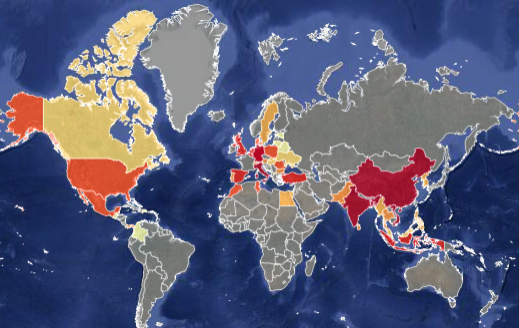Where Does Your Shirt Come From?

Just a few weeks after more than 1,100 people died in the collapse of an eight-story garment-factory building in Bangladesh, the ceiling of a shoe factory in Phnom Penh, Cambodia collapsed early Thursday, killing two workers and injuring seven.
These are just the latest in a series of deadly industrial disasters in economies that depend on low manufacturing costs and cheap labor. The average Bangladeshi garment-factory worker earns only $38 a month, according to the Associated Press.
World apparel exports (not including knitted garments), total about $200 billion a year, with India, Vietnam, Turkey, China and Hong Kong among the top exporters of cheap clothing, according to export stats gathered and compiled by the International Trade Center.
Check out this interactive map of the world’s top 50 apparel manufacturers. A darker color indicates a larger share of the apparel export market. International Business Times used 2011 export data, the most recent comprehensive dataset available.
China tops the list, with a 31 percent share of the world’s apparel exports. But that may be shifting as its apparel exports dropped for the first time in recent years, from $63 billion in 2011 to $61 billion in 2012. This may indicate that China is moving up the manufacturing ladder and shifting to making more expensive goods that require a more skilled labor force.
Though 2012 export data for Bangladesh, Vietnam and India are not yet available, the dollar value of apparel exported from those countries has been rising over the past few years, with the increase most noticeable in Bangladesh.
In 2011, Bangladesh apparel exports almost doubled in dollar value from their 2008 level -- from $5 billion to $9 billion.
Several economically advanced countries rank high on this list, including Italy and Spain. The apparel produced in these countries is usually of higher quality and sold at a higher price point than those manufactured in Bangladesh or Vietnam.
Most popular Western apparel and accessories brands get their lower-priced products produced in countries with low manufacturing costs. The factories that collapsed in Savar, Bangladesh, had Walmart, Joe Fresh, Primark, JC Penney, Benetton, Dress Barn, Cato Fashion and The Walt Disney Company among their clients, according to Time magazine.
Most consumers of these brands don’t think much about where the goods come from -- until one of these disasters occurs and media reports shine a spotlight on the distant manufacturing operations. IBTimes reached out to several clothing manufacturers, including JC Penney, the Gap, Urban Outfitters and J. Crew, to inquire about where their production sites, but we received no response or were told the information was confidential.
However, some large retailers have made information about their suppliers available. Take a look at this map of all the factories from which H&M sources its products. A darker color indicates that H&M has a relationship with a larger number of factories in that country.
China ranks highest on H&M’s list, with 262 Chinese garment factories in the retailer’s supply chain. The powerhouse fashion retailer also sources from 181 factories in Turkey and 170 factories in Bangladesh.
© Copyright IBTimes 2024. All rights reserved.





















